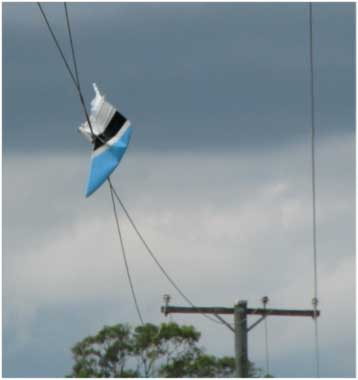Section 21 (2) of the Transport Safety Investigation Act
2003 (TSI Act) empowers the Australian Transport Safety Bureau
(ATSB) to discontinue an investigation at any time. Section 21 (3)
of the TSI Act requires the ATSB to publish a statement setting out
the reasons for discontinuing an investigation.
On 10 April 2010, the ATSB commenced an investigation into a
wirestrike that occurred at about 1737 Eastern Standard Time that
day and involved a Cessna Aircraft Co. A188B/A1 Ag Truck aircraft,
registered VH-JHR. The aircraft was being operated on an
agricultural weed-spraying flight over a cane field that was
located about 13km south-west of Ayr, Queensland. The aircraft was
positioned to fly under powerlines that crossed the intended flight
path at about 3.25 m above the top of the crop. The aircraft, which
is about 3.6 m high, contacted the powerlines and severed the top
of the aircraft's fin and rudder horn (Figure 1). Control of the
aircraft was lost and it collided with terrain shortly afterwards
in a steep, nose-down attitude. The pilot was fatally injured.
Figure 1: Power conductors and detached rudder
horn

In the hours prior to the flight, witness, video and other
information indicated that the pilot had consumed a quantity of
alcohol. A postmortem examination subsequently indicated that the
pilot had a high blood alcohol concentration.
The consumption of alcohol by pilots is regulated by Civil
Aviation Regulation 256, which mandates that a person shall
not:
- while in a state of intoxication, enter any aircraft
- act as, or perform any functions in preparation to act as a
member of the operating crew of an aircraft within 8 hours of
consuming alcohol - operate an aircraft if, by reason of having consumed alcohol
(or other prescribed substances), that person's ability to operate
the aircraft is impaired.
The ATSB safety research report titled
Alcohol and Human Performance from an Aviation Perspective: A
review' found that alcohol use by pilots was a major
potential risk to flight safety. Of particular relevance,
alcohol:
- affects almost all forms of cognitive function, such as
information processing, attention, vigilance, perception and
reasoning - impairs registration, recall and the organisation of
information, which leads to increased reaction times and increased
errors - significantly impairs attention, especially in terms of tasks
requiring sustained, selective or divided attention - adversely affects psychomotor performance, particularly on
tracking tasks. Performance was found to suffer most when an
unexpected or unanticipated event occurred.
The ATSB's primary focus is on enhancing safety with respect to
fare-paying passengers and, in particular, those transport safety
matters that may present a significant threat to public safety and
are the subject of widespread public interest. The ATSB therefore
needs to direct significant attention to identifying systemic
failures in aviation, marine and rail mass public transport
systems.
Many accidents involve the repetition of past occurrences, where
the contributing factors are similar and the safety issues are well
known. The ATSB has investigated a number of accidents in which the
operating crew were affected by alcohol and the cognitive
impairment likely as a result of alcohol consumption, and its
effects on tasks such as flying and driving, are well known. Given
that existing knowledge, and the pilot's decision to carry out the
flight after consuming alcohol, the ATSB considered there was
limited potential to enhance transport safety by continuing this
investigation.
On that basis, the ATSB has elected to discontinue the
investigation. However, the data collected in the course of the
investigation may be used by the ATSB for future statistical
analysis and safety research purposes.


